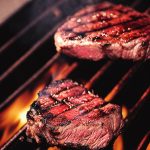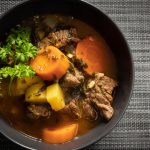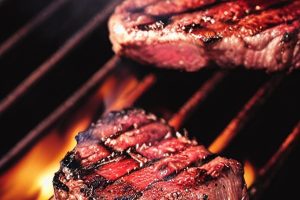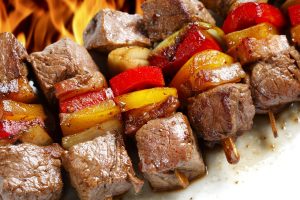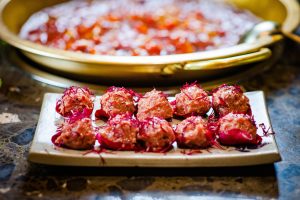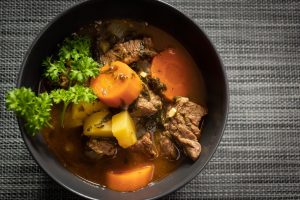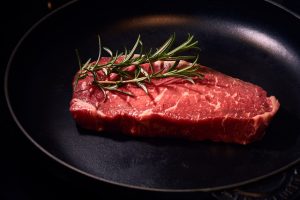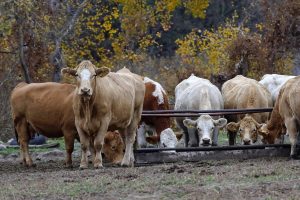Uncovering the Origins: The Fascinating History of Moo Shu Beef
Moo Shu Beef, a popular Chinese dish often found on the menus of American Chinese restaurants, has a fascinating history that stretches back centuries. Its origins can be traced to the northern regions of China, where it was originally known as “mu xu rou,” which translates to “wood shavings pork.” Over time, this dish evolved and made its way to the United States, where it gained popularity and underwent further modifications to suit the American palate.
The name “mu xu rou” came from the way the dish was traditionally prepared. Thin strips of pork were marinated and then cooked over a wood fire, resulting in a smoky flavor and a tender texture. The cooked pork was then shredded into thin strips, resembling wood shavings, hence the name.
As the dish gained popularity in northern China, it made its way to the capital city of Beijing. There, it underwent some changes to adapt to the taste preferences of the locals. The pork was replaced with beef, which was more readily available and favored by the people of Beijing. This variation became known as “mu xu niu,” or “wood shavings beef.”
In the early 20th century, Chinese immigrants began to arrive in the United States, bringing their culinary traditions with them. As they settled in cities like San Francisco and New York, Chinese restaurants started to pop up, catering to both the local Chinese community and curious Americans.
Moo Shu Beef quickly became a favorite among Americans, who were drawn to its flavorful combination of shredded beef, vegetables, and savory sauce. However, to make it more appealing to the American palate, some modifications were made to the original recipe. The addition of ingredients like cabbage, carrots, and mushrooms gave the dish a more colorful and diverse flavor profile.
The cooking technique also evolved to suit the restaurant setting. Instead of cooking the meat over a wood fire, it was stir-fried in a hot wok, allowing for quick and efficient preparation. This change in cooking method gave Moo Shu Beef its signature tender and slightly crispy texture.
Today, Moo Shu Beef continues to be a popular dish in American Chinese cuisine. It is often served with pancakes or tortillas, which are used to wrap the meat and vegetables, along with a generous dollop of hoisin sauce. This combination of flavors and textures has made Moo Shu Beef a beloved and iconic dish in Chinese-American cuisine.
In conclusion, the origins of Moo Shu Beef can be traced back to northern China, where it was originally known as “mu xu rou.” As it made its way to the United States, it underwent modifications to suit the American palate, resulting in the beloved dish we know today. Its rich history and cultural significance make Moo Shu Beef a fascinating part of Chinese-American culinary heritage.
From Ancient China to Your Plate: Tracing the Evolution of Moo Shu Beef
From Ancient China to Your Plate: Tracing the Evolution of Moo Shu Beef
Hey there foodies! Today, we’re going to take a journey through time and explore the fascinating history of one of our favorite Chinese dishes: moo shu beef. Get ready to be amazed as we uncover the ancient roots of this delectable dish and how it has evolved to satisfy our modern taste buds. So, grab a snack and let’s dive in!
Moo shu beef’s story begins in ancient China, where it was originally known as “mu xu rou” or “wood ear mushroom with pork.” Yep, you heard that right – the dish actually started out without any beef! Back then, pork was the main protein used in this dish, along with wood ear mushrooms. These mushrooms were believed to have medicinal properties and were highly valued for their crunchy texture.
As time went on, the dish underwent some changes and eventually made its way into the royal kitchens of the Ming Dynasty. It was during this period that moo shu beef got its name. “Moo shu” is actually a Mandarin term that means “to slice and cook quickly,” which perfectly describes the cooking technique used to prepare this dish. The beef was added as an alternative protein to pork, and the combination of thinly sliced beef, wood ear mushrooms, and other vegetables became a hit among the royal court.
Fast forward to the 20th century, when Chinese immigrants brought their culinary traditions to the United States. In the 1960s, moo shu beef made its way onto American Chinese restaurant menus. However, to cater to the American palate, a few tweaks were made to the original recipe. The addition of scrambled eggs and the use of hoisin sauce became popular modifications, adding a sweet and savory flavor to the dish.
Today, moo shu beef has become a beloved staple in Chinese-American cuisine. It’s a dish that embodies the fusion of traditional Chinese flavors with American influences. You’ll find it on the menus of countless Chinese restaurants across the country, and it has even gained popularity in other parts of the world.
So, the next time you dig into a plate of moo shu beef, take a moment to appreciate the rich history behind this mouthwatering dish. From its humble beginnings in ancient China to its modern incarnation on your plate, moo shu beef is a testament to the evolution of culinary traditions and the delicious results that come from cross-cultural influences. Enjoy every bite, and remember to savor the flavors of the past that have made their way to your present-day feast.
Exploring the Culinary Heritage: How Moo Shu Beef Became a Chinese Classic
Moo Shu Beef is a beloved Chinese dish that has been enjoyed by people all over the world. But have you ever wondered how this tasty dish became a classic in Chinese cuisine? Let’s take a journey into the culinary heritage of Moo Shu Beef and discover its fascinating origins.
Moo Shu Beef can be traced back to the northern region of China, specifically the Shandong province. This dish was initially created as a way to use up leftover ingredients and make a delicious meal out of them. It was often made with thin slices of beef, along with various vegetables such as cabbage, mushrooms, and bean sprouts.
The name “Moo Shu” actually comes from the Mandarin word “mù xū,” which means “wood shavings.” This is because the traditional way of preparing the dish involves shredding the ingredients into thin strips, resembling wood shavings.
In the early days, Moo Shu Beef was typically served with Mandarin pancakes, which are soft and thin and perfect for wrapping up the savory filling. These pancakes were also made from scratch, using a simple mixture of flour, water, and sometimes eggs. The combination of the flavorful beef and vegetables with the soft and chewy pancakes created a delightful culinary experience.
As Chinese immigrants began to settle in different parts of the world, they brought their culinary traditions with them. Moo Shu Beef quickly gained popularity in Chinese restaurants in America, where it was often served with hoisin sauce and eaten as a wrap. This version of the dish became a favorite among Americans, who loved the combination of flavors and textures.
Over time, variations of Moo Shu Beef started to emerge. Some restaurants began adding other ingredients such as scrambled eggs or bamboo shoots to enhance the flavor. Others experimented with different sauces and seasonings to create their own unique twist on the dish.
Today, Moo Shu Beef remains a staple in Chinese cuisine, both in China and abroad. It continues to be loved for its simplicity, versatility, and delicious taste. Whether you enjoy it with pancakes or as a wrap, there is no denying the appeal of this classic dish.
So next time you order Moo Shu Beef at your favorite Chinese restaurant, take a moment to appreciate the rich culinary heritage behind it. From its humble beginnings in northern China to its global popularity, this dish truly represents the diversity and creativity of Chinese cuisine.
The Intriguing Story Behind Moo Shu Beef: A Journey Through Time
Moo Shu Beef is a dish that has captured the taste buds of people around the world. With its flavorful combination of tender beef, crisp vegetables, and savory sauce, it’s no wonder that this dish has become a favorite on Chinese restaurant menus everywhere. But have you ever wondered about the story behind this intriguing dish? Join me on a journey through time as we explore the origins and evolution of Moo Shu Beef.
The history of Moo Shu Beef can be traced back to Northern China, where it was originally known as “moo shu pork.” This traditional dish was made with thinly sliced pork, marinated in a soy sauce-based mixture, and stir-fried with a variety of vegetables. It was typically served with Mandarin pancakes, which were soft and pliable, perfect for wrapping up the flavorful filling.
The dish gained popularity in the United States during the mid-20th century, thanks to the efforts of Chinese immigrants who brought their culinary traditions with them. As Chinese cuisine began to gain traction in America, a variation of the original moo shu pork recipe emerged, featuring beef as the main protein instead.
The transition from pork to beef was a natural progression, as beef was more readily available and favored by many Americans. This adaptation gave birth to the modern-day Moo Shu Beef, which has become a staple in Chinese-American cuisine.
Today, Moo Shu Beef is often made by stir-frying thinly sliced beef with an assortment of vegetables such as cabbage, carrots, and mushrooms. The key to its distinct flavor lies in the sauce, which typically consists of a combination of soy sauce, hoisin sauce, and other seasonings. The mixture is then wrapped in thin pancakes, similar to the original Mandarin pancakes, and served with additional hoisin sauce for dipping.
While Moo Shu Beef has evolved over time, its essence remains the same – a delicious and satisfying combination of flavors and textures. It’s a dish that captures the essence of Chinese cuisine while also reflecting the cultural diversity and adaptability that defines American food.
So the next time you find yourself enjoying a plate of Moo Shu Beef, take a moment to appreciate the journey it has taken to reach your table. From its humble beginnings in Northern China to its transformation into a beloved dish in America, Moo Shu Beef is a testament to the power of culinary traditions and the ability of food to bring people together. Enjoy every bite and savor the story behind this intriguing dish.
Digging into the Past: Unraveling the Historical Roots of Moo Shu Beef
Moo Shu Beef, a popular Chinese dish enjoyed by many, has a rich and interesting history. In this article, we will take a deep dive into the past and unravel the historical roots of this delicious dish. So, grab a cup of tea and get ready to travel back in time with us!
The origins of Moo Shu Beef can be traced back to northern China, specifically to the Shandong province. This region is known for its diverse and flavorful cuisine, and Moo Shu Beef is no exception. The dish is believed to have been created during the Ming Dynasty, which lasted from 1368 to
-
During this time, the Ming Dynasty was known for its opulence and love for fine dining. It was also a period of great cultural exchange and trade, with merchants from different regions bringing their culinary traditions to the capital city of Beijing. It is in this bustling city that Moo Shu Beef first gained popularity.
Moo Shu Beef is a stir-fried dish that typically consists of thinly sliced beef, mushrooms, cabbage, and other vegetables. The ingredients are cooked in a flavorful sauce made from soy sauce, vinegar, and other seasonings. The dish is traditionally wrapped in a thin pancake made from flour, creating a delightful combination of textures and flavors.
The name “Moo Shu” comes from the Mandarin word “mù xū,” which means “wood shavings.” This name is believed to have originated from the way the ingredients in the dish are cut into thin strips, resembling wood shavings. The addition of beef to the dish is said to have been influenced by the Mongolian nomads who frequented the capital city and brought their love for meat dishes.
Over time, Moo Shu Beef spread beyond the borders of Beijing and became a popular dish in other parts of China. It is believed that the dish’s popularity was further boosted during the Qing Dynasty, which followed the Ming Dynasty. The Qing Dynasty saw an influx of immigrants from different regions of China, who brought their own culinary traditions with them. These immigrants helped to spread the popularity of Moo Shu Beef to other parts of the country.
In more recent years, Moo Shu Beef has gained international recognition and can be found on the menus of Chinese restaurants around the world. Its unique combination of flavors and textures has made it a favorite among both locals and tourists alike.
So, the next time you enjoy a plate of Moo Shu Beef, take a moment to appreciate its historical roots. From its humble beginnings in the Ming Dynasty to its global popularity today, this dish truly embodies the rich and diverse culinary heritage of China.
